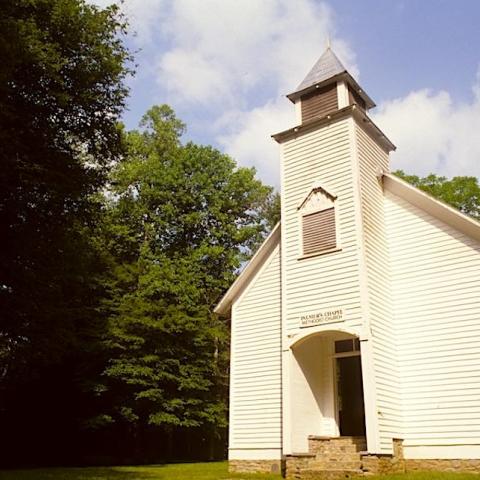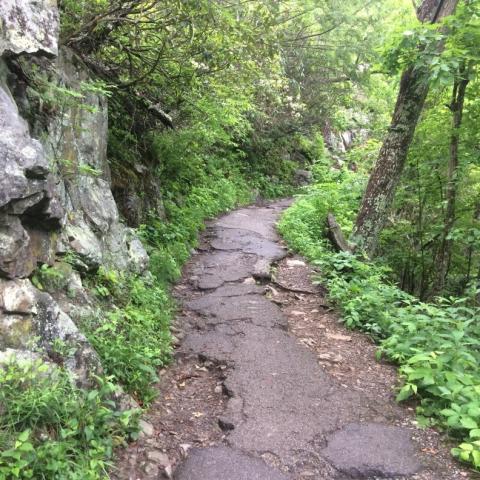Creeks, streams, and rivers provide a sense of place, a grounding at times, an identity for surrounding communities. They provide a recreational outlet, and can provide food, but often it's that sense of place that roots deepest. Hurricane Helene disrupted all that when it climbed out of Gulf of Mexico and reached deep into southern Appalachia.
Even today, seven months after the rain stopped and the sun came out, Helene's impact remains very visible.
"It had been already raining for over a week, and then Helene hit, and the wind was so powerful and the rain just kept coming," recalled Erin McCoombs, who lives in Asheville, North Carolina, the storm's "ground zero" for many. "When the whole thing came into focus, it wasn't just Asheville, it was this entire region that had the biggest flood that we've ever seen."
Throughout the region rivers — the French Broad, Cane, Nolichucky, Swannanoa, and Pigeon, just to name five — swelled high out of their banks, sweeping away trees and structures, vehicles and roads. The devastation was so thorough and far-reaching that American Rivers, in its annual list of endangered rivers across the United States, has included the "Rivers of Southern Appalachia" on that list.
"Houses, businesses, the hearts of our community are just, you know, really devastated," McCoombs, American Rivers' Southeast conservation director, said the other day. "And of course, our community is quite resilient, we banded together, and, you know, we are recovering, but that is a process, and that's going to take a really long time."

The hurricane filled the French Broad River with debris near the River Arts District in Asheville, North Carolina/Hartwell Carson
Though the rivers placed in this specific category don't flow through Great Smoky Mountains National Park, which drapes the Tennessee-North Carolina border with its rumpled mountains, the Blue Ridge Parkway does cross the French Broad River as it comes into Asheville. Beyond that, though, they are emblematic of many of the rivers in the region, and many of the communities that surround the parks and welcome their visitors have been impacted.
Their listing falls in step with American Rivers' decision this year to list 10 rivers that hold significance to people and nature, or are rivers (and their communities) that are threatened, or where a major decision affecting the river that the public can influence is pending.
"People used to say that Asheville was a climate haven," McCoombs pointed out. "And I think what we've learned is that really nowhere is immune from the impacts of climate change and extreme weather. Helene had the fingerprints all over it. That's why we're listing this ... it's not just one river that was hit. It was this whole region, so the rivers of southern Appalachia. That's why we're wanting to call attention that we're still recovering here. The most visited national park is the Smokies right? And the people from all over to come visit and enjoy this area. And we have so much of our economy tied to the tourist industry. You know, people coming through on the Blue Ridge Parkway, or people coming to visit the Great Smoky Mountains National Park and so many other things. We're hoping that we can call a lot of attention to say we're still recovering, or we're going to be recovering for a while."
Helene "hit more than four states, and the rivers in this region were really impacted," she added. "So just picking out one just didn't seem quite right. You know, it is more of a regional call to action, which also speaks to the scale of the disaster."

Map of American Rivers' Endangered Rivers for 2025/American Rivers
Work continues to remove debris from the rivers, assess dams that failed or were damaged by flooding, and even revegetate river banks.
"We're just coming into spring. We're just coming into when the recreation season is going to be heating up," said McCoombs. "And these rivers carried homes and businesses and cars and trees and trash and have looked pretty frightening. So one of the biggest things is that we need the storm debris to be removed so that we can actually have a recreation industry."
How long the work takes is hard to say.
"That's a great question," she said. "I think that the horizon is years."
Other units of the National Park System that are touched by rivers on this year's endangered list include the Captain John Smith Chesapeake National Historic Trail in Virginia, Gateway Arch National Park in Missouri, Gauley River River National Recreation Area in West Virginia, and Paterson Great Falls National Historical Park in New Jersey.
Captain John Smith Chesapeake National Historic Trail
Located in Virginia, this park system unit is touched by the Rappahannock River, which flows from the Blue Ridge Mountains down to the Chesapeake Bay. According to American Rivers, the Rappahannock is at risk because of "declining groundwater levels and a lack of comprehensive water supply planning amidst rapid population growth and expanding industries."

The Rappahannock River/Eric Brito
The river's poor health is of great concern to the Rappahannock Tribe, which three years ago regained 465 acres along a four-mile stretch of sandstone bluffs on the north bank of the Rappahannock River, a place where Captain John Smith first encountered the tribe in 1608. The site, known as Fones Cliffs, long has been sacred to the tribe. Prior to contact with the English, the Rappahannock Tribe lived in at least three villages on the Cliffs––Wecuppom, Matchopick, and Pissacoack. Fones Cliffs is located within the authorized boundary of the Rappahannock River Valley National Wildlife Refuge.
“The well-being of the Rappahannock River and the Rappahannock Tribe is inseparable. The Rappahannocks consider the River as their mother who has provided sustenance to our people for thousands of years. Her people attribute her as how they have survived to this day therefore, they honor and care for her as one would for their own mother. The marshes, migratory fisheries, and bird habitat have sustained the Rappahannock people for generations. After hundreds of years of separation from the Rappahannock River the Tribe finally repatriated 400 acres of its lost homeland on the river in 2022. It is cruel to give away the Tribe’s River, without due diligence, just as they returned to their land,” said Jack Ryan, the tribe's director of environmental and natural resource programs.

The Fones Cliffs area in Virginia above the Rappahannock that the Rappahannock Tribe regained in 2022/Chesapeake Conservancy, Jeffrey Allenby
Gateway Arch National Park
The Mississippi River, which flows past the park, is the top-ranked river in American River's 2025 list because of "hundreds of layoffs at the Federal Emergency Management Agency (FEMA) and calls to abolish both the agency itself and the National Flood Insurance Program."
“The Mississippi River is vital to our nation’s health, wealth and security. We drink from it, we grow our food with it, we travel on it, we live alongside it, and simply, we admire its beauty,” said Mike Sertle, Central region director for American Rivers. “We cannot turn our back on Mississippi River communities or the health of the river millions depend on at this critical time when they need unified direction instead of uncertainty at the national level.”
According to the organization, "[L]ongstanding threats to the river include chemical runoff that has led to regular toxic algae outbreaks in significant stretches of the river as well as hypoxic dead zones, sea level rise that is accelerating wetland loss and saltwater intrusion, exacerbating droughts, and infrastructure like levees and navigation structures that negatively impact the natural flow of the river."
“Ensuring the health of the Mississippi River is essential for both wildlife and communities that rely on its waters,” said Jessie Ritter, associate vice president, waters and coasts with National Wildlife Federation. “The river supports diverse ecosystems, provides drinking water to millions, and serves as a critical artery for economic activity. We must unite together to ensure that the Mississippi River remains a source of life, prosperity, and inspiration now and for future generations to come.”
Gauley River River National Recreation Area
The Gauley is threatened by toxic pollution from coal strip mining in the headwaters of one of the Gauley's primary tributaries—the Cherry River, says American Rivers.
South Fork Coal Company, which filed for bankruptcy protection in February, has 36,000 acres in Greenbrier County under lease and operates a network of strip mines, haul roads, and a coal preparation plant. "These mines have violated water pollution standards at least 80 documented times since 2019, releasing sediment and toxic heavy metals—at times exceeding legal limits by more than 900 percent—into the river," said American Rivers.
“For four years, this company has illegally operated within the Monongahela National Forest,” said Willie Dodson, coal impacts program manager at Appalachian Voices. “Now, having just declared bankruptcy, South Fork Coal is asking regulators to retroactively validate this activity. It’s unacceptable. If they get away with it, I shudder to think what the next encroachment by the coal industry into our public land will be. Are they going to strip Spruce Knob? Are they going to put a sludge dam at Cranberry Glades? This is the time to draw a line in the sand.”
America Rivers underscores that the "Gauley supports an outdoor-recreation economy that generates hundreds of millions of dollars annually. The Cherry River and other Gauley headwater streams lie largely within the Monongahela National Forest, home to old-growth stands and an extraordinary array of wildlife, from the rare northern flying squirrel and the eastern hellbender salamander to the brilliantly hued endangered candy darter."
Paterson Great Falls National Historical Park
The Passaic River that flows over falls in the park has a history of "rampant contamination [from] more than two centuries by chemical manufacturing — including of Agent Orange and DDT," noted American Rivers.
“For far too long, the Passaic River has remained one of the most contaminated waterways in our nation,” said U.S. Sen. Cory Booker (D-NJ). “Toxic waste dumped by corporate polluters into the river threatens the health of surrounding communities. It is critical that the Environmental Protection Agency prioritizes the cleanup work that has been dragging on for decades and hold responsible parties, such as Occidental Chemical Corporation, accountable until the river is completely clean and restored."
The river, said American Rivers, "suffers from a high accumulation of toxic waste that includes heavy metals, PCBs, and very high concentrations of dioxins in the riverbed sediments in the river’s tidal zone below Dundee Dam. The worst of this pollution is located in the lowermost eight miles, from Belleville, New Jersey to Newark Bay."






 Support Essential Coverage of Essential Places
Support Essential Coverage of Essential Places






